Nestled along the banks of the Chao Phraya River, Wat Arun stands as a testament to Bangkok’s rich history and architectural prowess. Often referred to as the “Temple of Dawn,” this iconic structure has captivated travelers and locals alike with its intricate designs and spiritual significance. Whether witnessing its spire illuminated by the setting sun or exploring its ornate chambers, Wat Arun promises an experience like no other. Join us at Mihitravel as we delve into the allure of this magnificent temple and uncover the stories within its walls.
Best time to visit Thailand – All of things you maybe need
Wat Arun
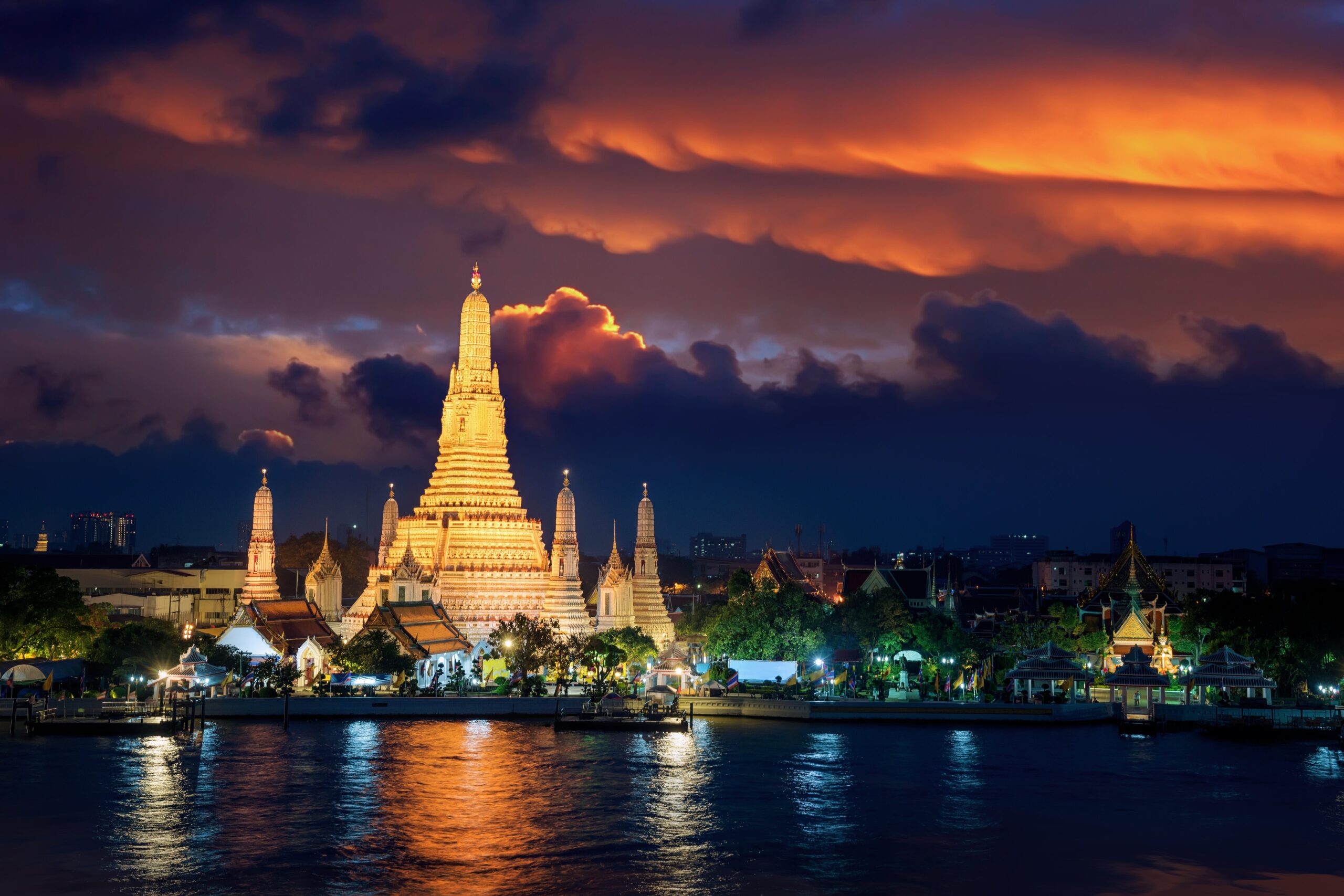
Location: 158 Wang Doem Road, Wat Arun, Bangkok Yai, Bangkok 10600, Thailand, Google Map
Open: Daily from 8 a.m. to 5.30 p.m.
Phone: +66 (0)2 891 2185
Rising majestically from the banks of the Chao Phraya River, Wat Arun stands tall with its unique missile-like design. Often referred to as the “Temple of Dawn,” its name is derived from Arun, the Indian deity of dawn. The temple’s location holds historical significance, as it was where King Taksin found a modest shrine following Ayuthaya’s fall, taking it as a divine sign to establish the new Siam capital.
Now, Wat Arun is a testament to Bangkok’s rich heritage, distinguishing itself as one of its landmarks. Remarkably, it’s among the few Buddhist temples where visitors are welcome to ascend.
Its defining feature, the 82m-high Khmer-style tower or “þrahng,” became prominent when the capital and the revered Emerald Buddha were relocated to Bangkok. Initiated by Rama II in the early 19th century, its construction was later finalized under Rama III’s reign.
A challenging climb up its steep steps rewards visitors with breathtaking vistas of the Chao Phraya River. A closer look reveals intricate floral mosaics crafted from multicolored fragments of Chinese porcelain – remnants from Chinese vessels that once docked at Bangkok’s port.
At the heart of the temple lies a Buddha statue, believed to be the handiwork of Rama II. The temple’s walls are adorned with murals from Rama V’s era, with one particularly captivating depiction of Prince Siddhartha’s profound encounters that led him towards enlightenment. A tribute to Rama II’s legacy, his ashes are enshrined within the temple’s primary Buddha statue.
History of Wat Arun
Wat Arun, a historic temple, has graced its location since the Ayutthaya Kingdom era; initially known as Wat Makok, named after the local village, Bang Makok. The name “Makok” is derived from the Thai term for the Spondias pinnata plant. Historical records, including French maps from King Narai’s reign, have documented its existence. The temple’s name was changed to Wat Chaeng by King Taksin after he set up his capital in Thonburi, adjacent to the temple, after the fall of Ayutthaya. Legend has it that Taksin pledged to rejuvenate the temple after seeing it at dawn. Notably, the revered Emerald Buddha was housed here before being relocated to Wat Phra Kaew in 1784. During Taksin’s rule, the temple was part of the royal palace grounds until King Rama I shifted the palace across the river.
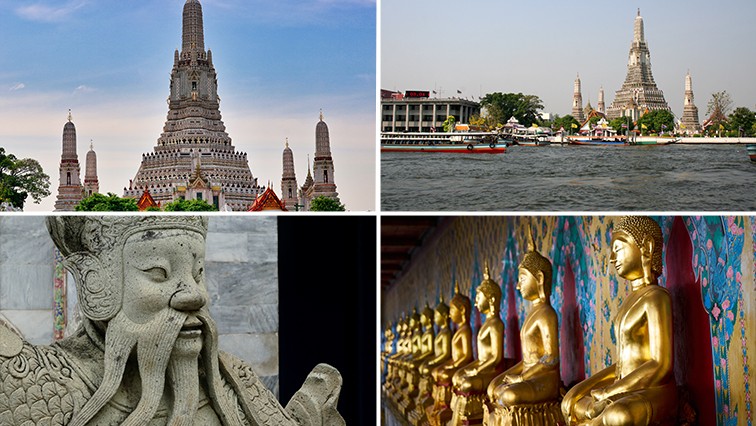
The temple remained neglected until King Rama II initiated its restoration and planned to elevate the main pagoda to 70 meters. The construction of the main prang was finalized in Rama III’s reign, taking nine years.
Subsequent significant restorations occurred under King Chulalongkorn in 1980, leading to Bangkok’s bicentennial celebrations. The most comprehensive restoration of the prang spanned from 2013 to 2017. This period saw the replacement of numerous damaged tiles and lime plaster for many surfaces, a shift from the previously used cement. However, as the restoration neared completion in 2017, the temple’s seemingly “white-washed” appearance drew criticism. In response, the Fine Arts Department asserted that the restoration aimed to mirror the temple’s original look.
Tickets and other practicalities
Wat Arun, a renowned temple, welcomes visitors daily from 8 a.m. to 6 p.m., with an entrance fee of 50 B. Its entrance is on Th Arun Amarin, located directly across the river from the famous Wat Pho.
While many opt to explore Wat Arun via long-tail boat tours, a convenient alternative is to take the Chao Phraya Express Boat. A cross-river ferry service is also available from Tien Pier, operating from 5 a.m. to 9 p.m.
What to see in Wat Arun
The Spire
At the heart of Wat Arun stands an impressive 82m-high Khmer-style tower known as þrahng. This iconic structure was built during the reign of Rama II (King Phraphutthaloetla Naphalai; r 1809–24) in the early 19th century. While its grandeur is evident from the river, a closer look reveals intricate floral murals crafted from glazed porcelain. This decorative technique was prevalent during the early Ratanakosin era, with the porcelain often being used as ballast by Chinese ships docking in Bangkok.
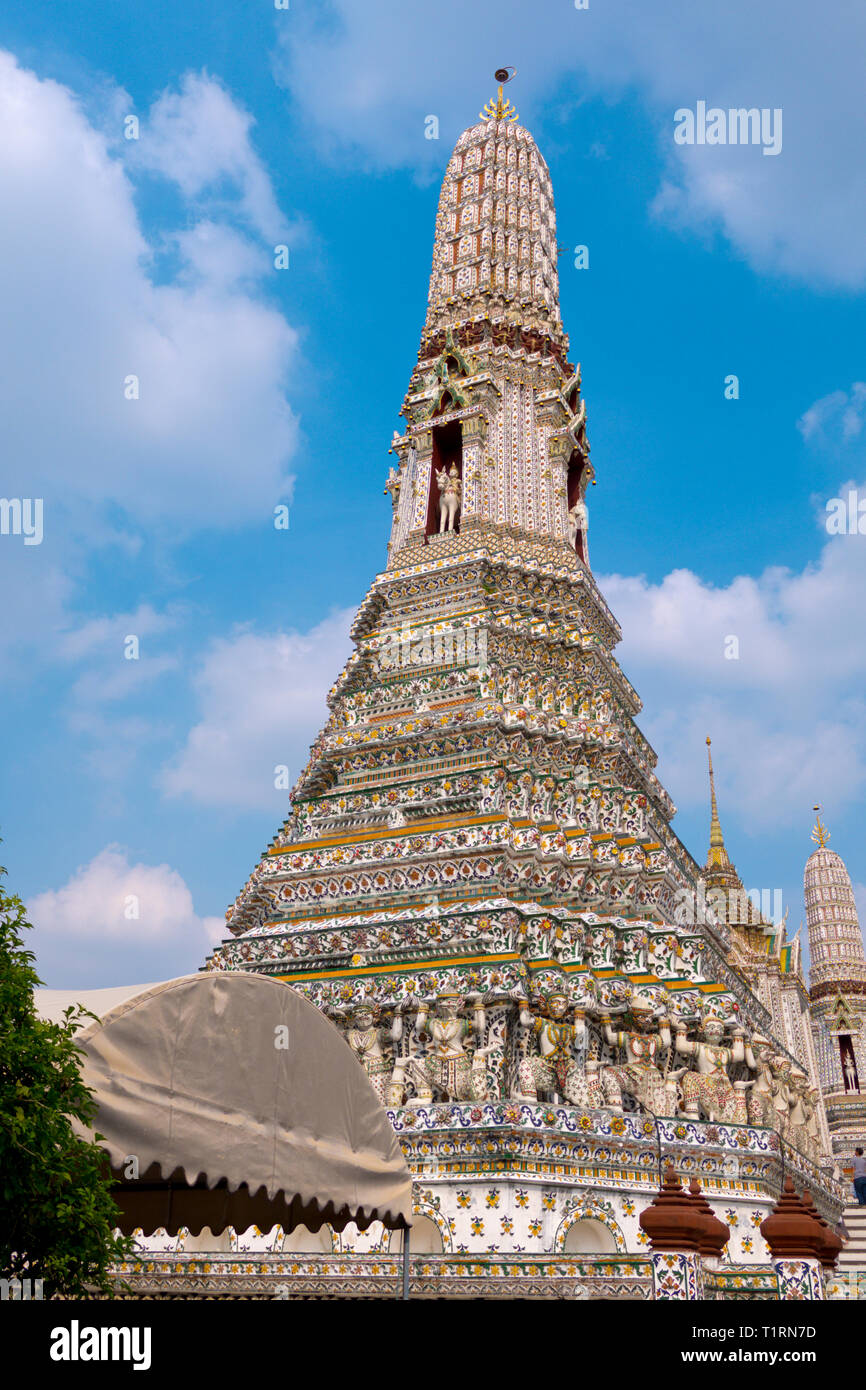
The Ordination Hall
Within the compound’s main bòht (ordination hall), visitors can find a Buddha statue believed to be crafted by Rama II’s own design. The walls of this hall are adorned with captivating murals illustrating Prince Siddhartha’s (later known as Buddha) profound encounters with birth, aging, illness, and death outside his royal palace, and these pivotal moments inspired him to forsake his royal comforts and seek a deeper understanding of life.
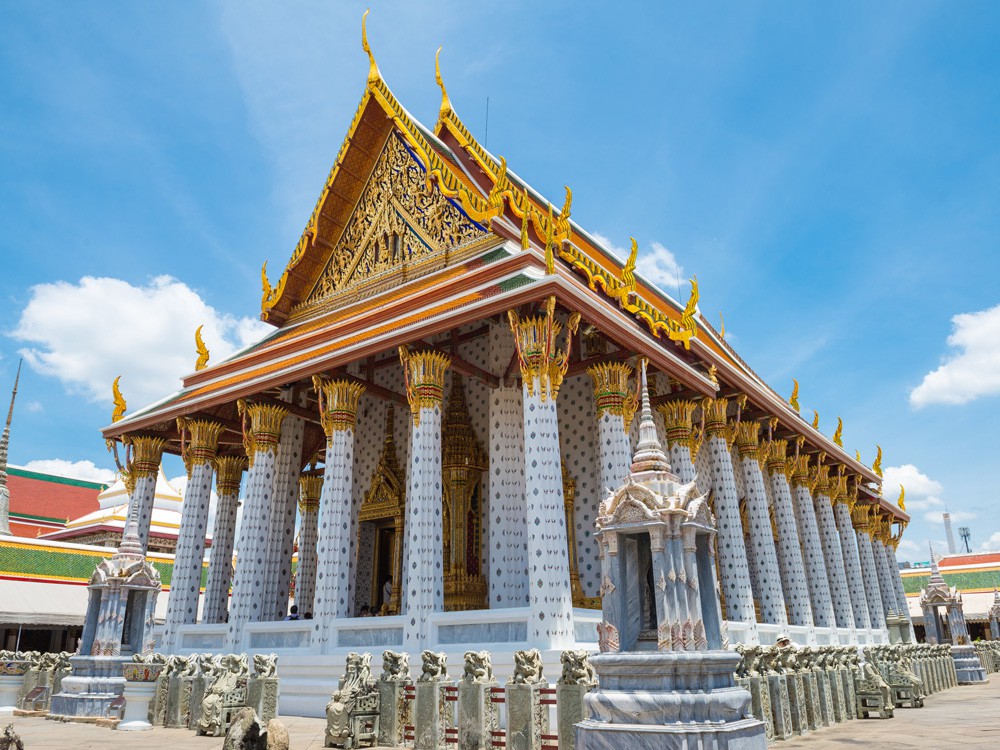
The Grounds
Beyond its iconic central spire and the main ordination hall, Wat Arun boasts a variety of architectural wonders. The compound houses two wí·hăhn (sanctuaries) and a hǒr đrai, a special structure dedicated to storing Buddhist scriptures. Visitors will find six săh·lah along the riverbank, open-air pavilions traditionally used for relaxation or scholarly pursuits. However, in recent times, these pavilions have been repurposed as docking points for the influx of tourist boats.
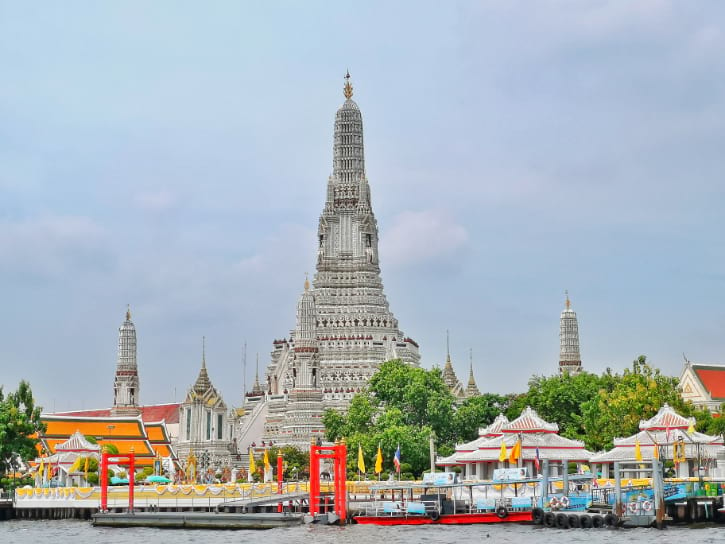
Dress code
Visitors to Wat Arun, a revered Buddhist temple, must dress respectfully. Appropriate attire includes long skirts or trousers and tops that cover the shoulders, with no transparent materials. In case of inappropriate clothing, sarongs are available for rent at the entrance for 20B, along with a 100B refundable deposit. Additionally, certain temple areas require visitors to remove their shoes before entering.
Wat Arun at sunset
The optimal time to visit Wat Arun is in the late afternoon when the western sun illuminates the temple’s spire and the river behind. For those seeking sunset shots, excellent views can be captured from the warehouses along Th Maha Rat on the opposite riverbank. However, be prepared as locals might request a 20B “fee” for the view. The most enchanting moment for photography is around 7 p.m. when the temple lights are turned on, and the sky still holds the twilight’s radiance.
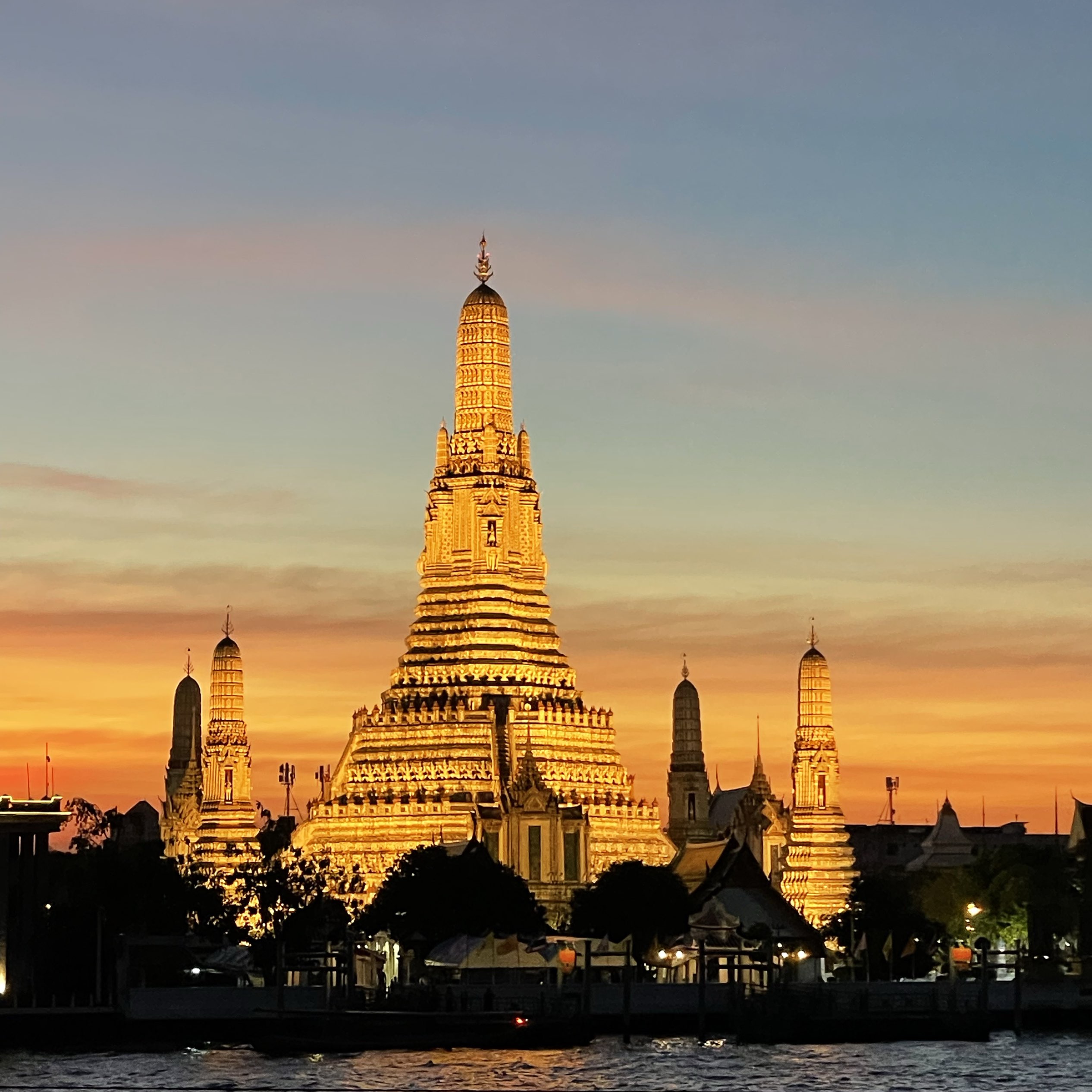
Tips when you visit
Devoting at least an hour to explore Wat Arun is highly recommended. While its name translates to the Temple of the Dawn, its beauty is unparalleled during sunset, especially when illuminated in the evening. For a serene experience, consider visiting early in the morning to avoid the influx of tourists.
Wat Arun’s exquisite architecture and meticulous craftsmanship have earned it a reputation as one of Thailand’s most magnificent temples. Its iconic prang (spire) by the Chao Phraya is a testament to Bangkok’s rich heritage. Towering at over 70 meters, the spire is adorned with intricate patterns made from fragments of colored glass and Chinese porcelain, making it a sight to behold.
Maybe you need:
- Best Beaches in Thailand that you can’t miss
- Miya Hillside Thailand: A Serene Escape into Nature’s Beauty
As the sun sets over the Chao Phraya River, the silhouette of Wat Arun stands as a timeless beacon, reminding us of the rich tapestry of culture and history that Bangkok offers. From its intricate porcelain mosaics to its towering spires, every detail of this temple tells a story waiting to be discovered. If you’re seeking a journey that transcends the ordinary, let Mihitravel guide you through the mesmerizing corridors of Wat Arun. Don’t just read about it; experience it. Book your next adventure with Mihitravel and let the Temple of Dawn unveil its secrets.


